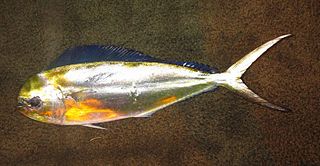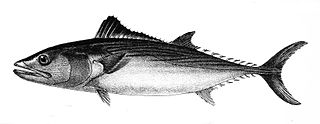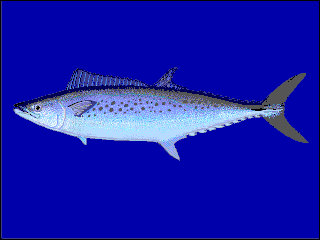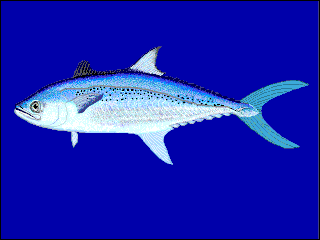
A tuna is a saltwater fish that belongs to the tribe Thunnini, a subgrouping of the Scombridae (mackerel) family. The Thunnini comprise 15 species across five genera, the sizes of which vary greatly, ranging from the bullet tuna up to the Atlantic bluefin tuna, which averages 2 m (6.6 ft) and is believed to live up to 50 years.

Mackerel is a common name applied to a number of different species of pelagic fish, mostly from the family Scombridae. They are found in both temperate and tropical seas, mostly living along the coast or offshore in the oceanic environment.

The pompano dolphinfish is a species of surface-dwelling ray-finned fish found in tropical and subtropical waters. They are one of only two members of the family Coryphaenidae, the other being the mahi-mahi or common dolphinfish.
Indo-Pacific king mackerel, popularly known as the "(spotted) seer fish", is a sea fish among the mackerel variety of fishes. It is found in around the Indian Ocean and adjoining seas. It is a popular game fish, growing up to 45 kg (99 lb)), and is a strong fighter that has on occasion been seen to leap out of the water when hooked.

The streaked Spanish mackerel is found mainly in and around India, especially along the Maharashtra and Gujarat coasts. The peak season for fishing this fish is from October to December. It is also known by other names, such as streaked seer, hazard (French), sawara, and carite (Spanish). It is found off Asian coasts from the west coast of India and Sri Lanka east to Java and does not extend east of Wallace's Line. It is an important quarry species for fisheries where it occurs.

The billfish are a group of saltwater predatory fish characterised by prominent pointed bills (rostra), and by their large size; some are longer than 4 m (13 ft). Extant billfish include sailfish and marlin, which make up the family Istiophoridae; and swordfish, sole member of the family Xiphiidae. They are often apex predators which feed on a wide variety of smaller fish, crustaceans and cephalopods. These two families are sometimes classified as belonging to the order Istiophoriformes, a group which originated around 71 million years ago in the Late Cretaceous, with the two families diverging around 15 million years ago in the Late Miocene. However, they are also classified as being closely related to the mackerels and tuna within the suborder Scombroidei of the order Perciformes. However, the 5th edition of the Fishes of the World does recognise the Istiophoriformes as a valid order, albeit including the Sphyraenidae, the barracudas.

The butterfly kingfish is an ocean-dwelling ray-finned bony fish in the mackerel family, Scombridae – a family which it shares with the tunas, mackerels, Spanish mackerels, and bonitos. Unlike the 50 species from those four tribes, however, this species is unique in that it is the only scombrid to be classified apart from the rest, into the subfamily Gasterochismatinae and genus Gasterochisma.

Sarda chiliensis, the eastern Pacific bonito, is a marine species of bonito. It ranges from Ecuador to Chile. Sarda lineolata, which ranges from Alaska to Mexico was formerly considered a subspecies, as Sarda chiliensis lineolata, but this treatment renders the species geographically disjunct.

Makaira is a genus of marlin in the family Istiophoridae. It includes the Atlantic blue, and Indo-Pacific blue marlins. In the past, the black marlin was also included in this genus, but today it is placed in its own genus, Istiompax.
The Papuan seerfish also called the Papuan Spanish mackerel, is a species of fish in the family Scombridae. It is endemic to the Gulf of Papua off the mouth of the Fly River. It is the smallest species in the genus Scomberomorus. Sexual maturity is attained at much less than 30 cm fork length.

The Australian spotted mackerel is a species of fish in the family Scombridae. Common fork length ranges between 50 and 80 cm. Specimens have been recorded at up to 104 cm in length, and weighing up to 10.2 kg. It is found in the western Pacific, along the northern coast of Australia, from the Abrolhos Islands region of Western Australia to Coffs Harbour and Kempsey in central New South Wales. It is also found in southern Papua New Guinea from Kerema to Port Moresby. It feeds largely on fishes, particularly anchovies and sardines, with smaller quantities of shrimps and squids. It is sometimes confused with Japanese Spanish mackerel, S. niphonius. Conservation status of the species has been evaluated as Near Threatened by the IUCN. This species was described in 1980 and was previously confused with the Japanese Spanish mackerel of the north western Pacific but S. munroi has a different visceral structure, more vertebrae and fewer gill rakers.

The Kanadi kingfish is a species of ray-finned bony fish in the family Scombridae, the mackerel family. Also known as the Kanadi seerfish, queen mackerel, or spotted mackerel, it is found in subtropical waters of the western Indian Ocean, Seychelles, Kenya and Zanzibar to South Africa and along the west coast of Madagascar. Kanadi kingfish commonly occur in depths of 50 to 200 m. Specimens have been recorded at up to 120 cm (47 in) in length, and weighing up to 12.5 kg (28 lb). They feed mainly on small fishes such as anchovies and clupeids, squids, and mantis shrimps.

Euthynnus affinis, the mackerel tuna, little tuna, wavyback skipjack tuna, kawakawa, or tongkol is a species of ray-finned bony fish in the family Scombridae, or mackerel family. It belongs to the tribe Thunnini, better known as the tunas. This is an Indo-Pacific species which is found from the Red Sea to French Polynesia.

Euthynnus lineatus, the black skipjack tuna or black skipjack, is a species of ray-finned bony fish in the family Scombridae. It belongs to the tribe Thunnini, better known as the tunas.

Thunnus tonggol is a species of tuna of tropical Indo-West Pacific waters.

The longbill spearfish is a species of marlin native to the Atlantic Ocean where it is found above the thermocline in open waters between 40°N and 35°S. This species can reach a length of 254 centimetres (100 in) FL and the maximum weight recorded is 58 kilograms (128 lb). It feeds on pelagic fishes such as needlefish, tuna, and jack, as well as squids. They spawn once a year. The specific name honours the Florida game fisherman and taxidermist Albert Pflueger Sr, who died in 1962.

The island mackerel is a species of true mackerel in the scombrid family (Scombridae) from the Indo-Pacific. Their maximum reported length is 20 cm, and the maximum reported weight is 0.75 kg.

Thunnus (Neothunnus) is a subgenus of ray-finned bony fishes in the Thunnini, or tuna, tribe. More specifically, Neothunnus is a subgenus of the genus Thunnus, also known as the "true tunas". Neothunnus is sometimes referred to as the yellowfin group, and comprises three species:

Thunnus (Thunnus) is a subgenus of ray-finned bony fishes in the Thunnini, or tuna, tribe. More specifically, Thunnus (Thunnus) is a subgenus of the genus Thunnus, also known as the "true tunas". Thunnus (Thunnus) is sometimes referred to as the bluefin group and comprises five species:

The Korean mackerel also known as the Korean seerfish, is a ray-finned bony fish in the family Scombridae, better known as the mackerel family. Within that family, this fish is a member of the tribe Scomberomorini, the Spanish mackerels. It has an Indo-Pacific distribution which extends from the east coast of India and Sri Lanka along the Asian continental shelf to Sumatra, then north to Korea and Wakasa Bay in the Sea of Japan. This species is of minor commercial importance in some parts of its range, where it is taken using gill nets and is marketed either fresh or dried-salted. The Korean mackerel is an important quarry species for the drift net fishery in Palk Bay and the Gulf of Mannar in India.


















